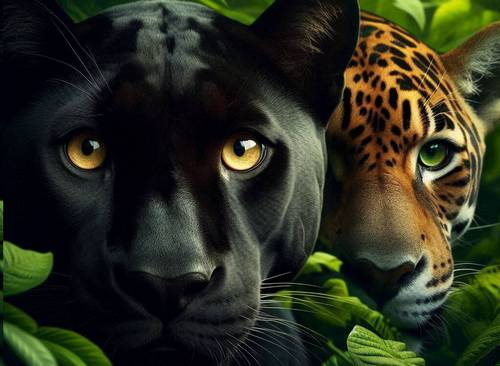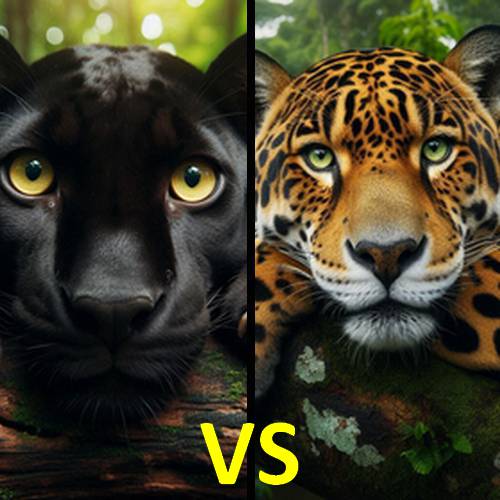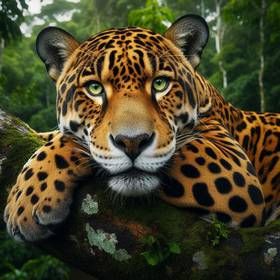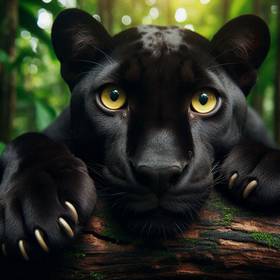Ever get those two big cats mixed up? You're not alone. People ask me all the time – "Is a panther just a black jaguar?"
Well, it's a bit like asking if all cookies are chocolate chip. Some are, but there's a whole world of snickerdoodles and peanut butter blossoms out there!
Here's the Complete Comparison Table: Panther vs. Jaguar
Let's break it down:
Panther isn't a species: It's like a cool nickname for a fashion choice. Jaguars and even leopards can rock the "black panther" look when their genes decide to pump up the melanin. Think of it like a natural camouflage makeover.
Jaguars are the stars in the Americas: They rule the jungles from South America up to parts of Central and even a little bit in North America.
Black panthers are elusive: They're like the ninjas of the jungle, blending right in. This stealth mode helps them snag some unsuspecting prey.
Size and Weight:
Jaguars are built like tanks! They can be 5-8 feet long and weigh anywhere from 100 to 250 pounds. That's heavier than your fridge!
Black panthers? Well, since they're just jaguars (or leopards) in a black coat, their size depends on what kind of cat they are underneath.
Built for Speed
Jaguars: Don't let their size fool you, these guys can hit the gas! Imagine a burst of muscle hitting nearly 50 mph – that's a jaguar chasing down its dinner.
Black Panthers: Remember, a black panther is just a jaguar or leopard with a different wardrobe choice. So, their speed depends on their base model.
Think of it like this:
You see a big spotted cat in Costa Rica suddenly bolting after prey? That's a jaguar showing off its speed.
Spot a sleek black cat in the Amazon melting into the shadows? Could be a black panther (a melanistic jaguar) using its camouflage for a stealthy hunt.
Stumble upon a black cat in Africa streaking through the trees? You found yourself a black leopard – also rocking the "panther" style and some serious speed!
So yeah, it can be confusing! But hey, at least now you can impress your friends with your big cat knowledge.
Well, it's a bit like asking if all cookies are chocolate chip. Some are, but there's a whole world of snickerdoodles and peanut butter blossoms out there!
Here's the Complete Comparison Table: Panther vs. Jaguar
Let's break it down:
Panther isn't a species: It's like a cool nickname for a fashion choice. Jaguars and even leopards can rock the "black panther" look when their genes decide to pump up the melanin. Think of it like a natural camouflage makeover.
Jaguars are the stars in the Americas: They rule the jungles from South America up to parts of Central and even a little bit in North America.
Black panthers are elusive: They're like the ninjas of the jungle, blending right in. This stealth mode helps them snag some unsuspecting prey.
Size and Weight:
Jaguars are built like tanks! They can be 5-8 feet long and weigh anywhere from 100 to 250 pounds. That's heavier than your fridge!
Black panthers? Well, since they're just jaguars (or leopards) in a black coat, their size depends on what kind of cat they are underneath.
Built for Speed
Jaguars: Don't let their size fool you, these guys can hit the gas! Imagine a burst of muscle hitting nearly 50 mph – that's a jaguar chasing down its dinner.
Black Panthers: Remember, a black panther is just a jaguar or leopard with a different wardrobe choice. So, their speed depends on their base model.
Think of it like this:
You see a big spotted cat in Costa Rica suddenly bolting after prey? That's a jaguar showing off its speed.
Spot a sleek black cat in the Amazon melting into the shadows? Could be a black panther (a melanistic jaguar) using its camouflage for a stealthy hunt.
Stumble upon a black cat in Africa streaking through the trees? You found yourself a black leopard – also rocking the "panther" style and some serious speed!
So yeah, it can be confusing! But hey, at least now you can impress your friends with your big cat knowledge.





